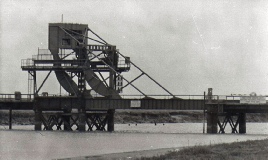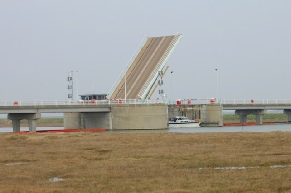
Havengore Bridge
From Great Wakering to Foulness Island
The Broomway
The old passage through Wakering (by Landwick) to Foulness was disused for many years, being impassable, and the only way on to the island was by boat or by foot across the Maplin Sands, where a hard track, called the Broomway which actually started at Wakering Stairs (near the security gate) and was 6 miles long. It was marked with broom branches every 30-50 feet, but high tides and strong winds could easily dislodge them. One access point was from Pigs Bay in South Shoebury (opposite Suttons). The Royal Mail used it to deliver post by horse and cart.
The sum of £15 (five of which was contributed by a Mr. Finch, and ten by the parish out of the church rate) was paid annually for keeping up and renewing the brooms on the shore, which indicated the route to follow to the island.
There were five headways leading to the Broomway: Shelford, Great Burwood* (now private), Rugwood, Eastwick, now known as Pattissons, and Fishermans. The old headway At Great Burwood became impassable. There were also three ferries, one between Foulness and Potton Island, another to the Burnham side of the Crouch river, and a third to Wallasea Island.
 The First Havengore Bridge
The First Havengore Bridge
The acquisition of New England and Foulness islands was completed by the War Department in 1914/15. In August 1915 a contract was placed with Findlay & Co Ltd. For the supply and erection of a Schherzer Rolling Lift Bridge over Havengore Creek. Scherzer was an American Company from Chicago.
The contract for the viaduct to run either side of the bridge was placed with Braithwaite Thirsk in February 1917 and piling started in June. There were a number of problems with the piling and completion of the viaduct stretched out to 1919 when the bridge was erected. The bridge had a split counterweight and was originally hand operated carrying a road and a military tramway. The bridge was later electrified.
The road to Churchend and Fisherman’s Head was completed in 1922-23. Jim Cork was the first Bridge Keeper and lived with his family in Bridge Cottage, adjacent to the bridge.
 The Second Havengore Bridge
The Second Havengore Bridge
The new Havengore Bridge was of bascule style. Note the barriers slung below the deck to prevent unauthorised entry.



© 2015 - Richard Kirton - All Rights Reserved | Privacy Policy | Terms of Use | Site Map

